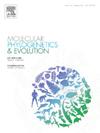Phylogenomics of the superfamily Lygaeoidea with proposals on taxonomic system (Hemiptera: Heteroptera)
IF 3.6
1区 生物学
Q2 BIOCHEMISTRY & MOLECULAR BIOLOGY
引用次数: 0
Abstract
Lygaeoidea, one of the largest superfamilies of the true bugs (Hemiptera: Heteroptera), currently comprises 16 families and exhibits abundant diversification in habitats, body plans, and feeding habits. The relationships within this superfamily are complex, and comprehensive molecular phylogenetic studies, particularly those focusing on subfamilies and tribes within Rhyparochromidae, have been lacking. In the present study, we sampled 125 lygaeoid species representing all 16 families of Lygaeoidea, with a focus on two subfamilies and 12 tribes within Rhyparochromidae. A phylogenetic dataset with 102 genes was assembled, including two nuclear rRNA genes (18S rDNA, 28S rDNA), two mitochondrial rRNA genes (12S rDNA, 16S rDNA), 13 mitochondrial protein-coding genes (PCGs) and 85 nuclear PCGs generated from the low-coverage genomes. Our inferences indicate that Rhyparochromidae is not monophyletic, with one subfamily, one tribe, and one genus deserving elevation to the rank of family. Additionally, this phylogenetic result is also supported by corresponding morphological evidence. Besides, the transfer of the Heissothignus from Heterogastridae to Meschiidae is supported by molecular evidence in this study.

Lygaeoidea超科的系统基因组学及分类系统建议(半翅目:异翅目)
瓢虫总科(半翅目:异翅目)是瓢虫中最大的超科之一,目前包括16科,在栖息地、体型和摄食习惯上都表现出丰富的多样性。这个超家族内部的关系是复杂的,缺乏全面的分子系统发育研究,特别是对Rhyparochromidae亚科和部落的研究。本研究共采集了曲蝇总科16科125种曲蝇,重点分析了曲蝇科2个亚科12个族。构建了包含102个基因的系统发育数据集,包括2个核rRNA基因(18S rDNA、28S rDNA)、2个线粒体rRNA基因(12S rDNA、16S rDNA)、13个线粒体蛋白编码基因(PCGs)和85个低覆盖基因组生成的核PCGs。我们的推断表明,Rhyparochromidae不是单系的,有一个亚科,一个部落,一个属值得提升到科的等级。此外,这一系统发育结果也得到了相应形态学证据的支持。此外,本研究还提供了分子证据来支持Heissothignus从异蝽科向中蝽科的转移。
本文章由计算机程序翻译,如有差异,请以英文原文为准。
求助全文
约1分钟内获得全文
求助全文
来源期刊
CiteScore
7.50
自引率
7.30%
发文量
249
审稿时长
7.5 months
期刊介绍:
Molecular Phylogenetics and Evolution is dedicated to bringing Darwin''s dream within grasp - to "have fairly true genealogical trees of each great kingdom of Nature." The journal provides a forum for molecular studies that advance our understanding of phylogeny and evolution, further the development of phylogenetically more accurate taxonomic classifications, and ultimately bring a unified classification for all the ramifying lines of life. Phylogeographic studies will be considered for publication if they offer EXCEPTIONAL theoretical or empirical advances.

 求助内容:
求助内容: 应助结果提醒方式:
应助结果提醒方式:


